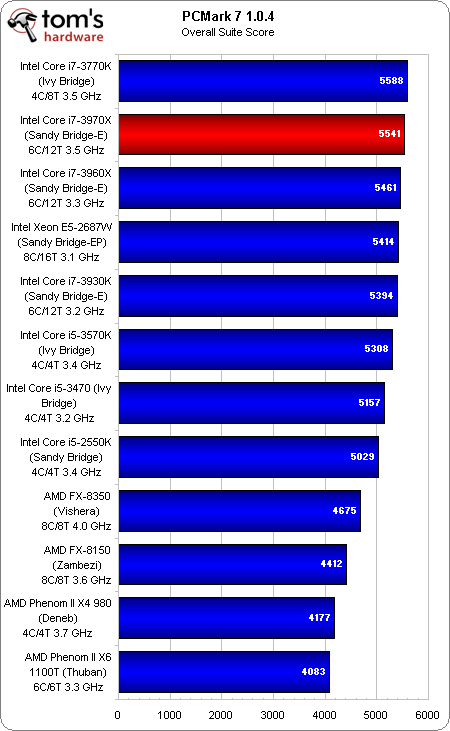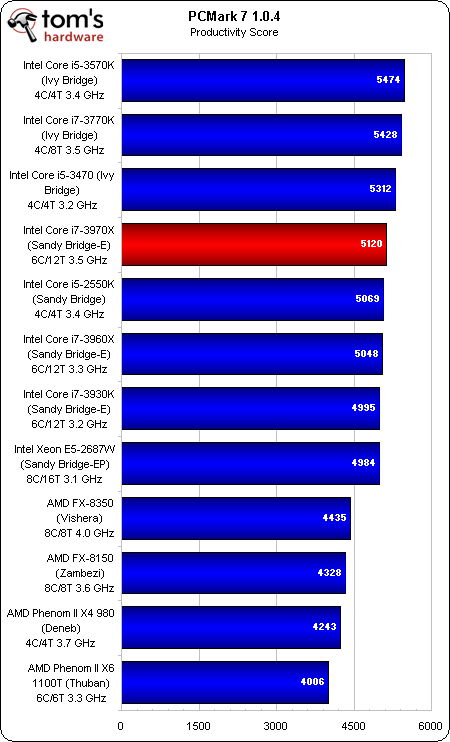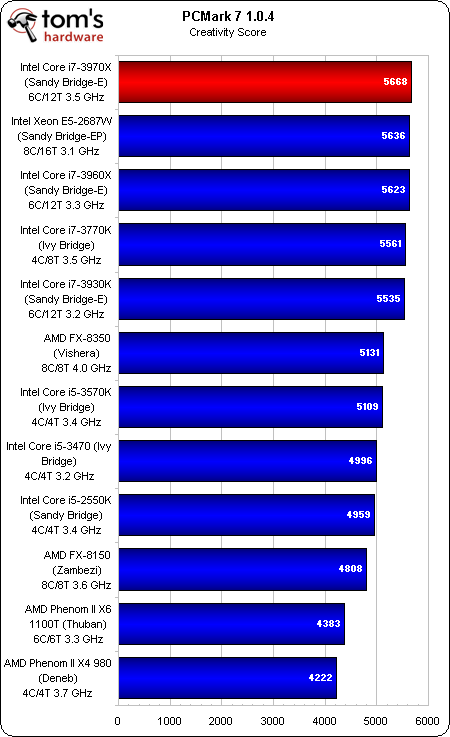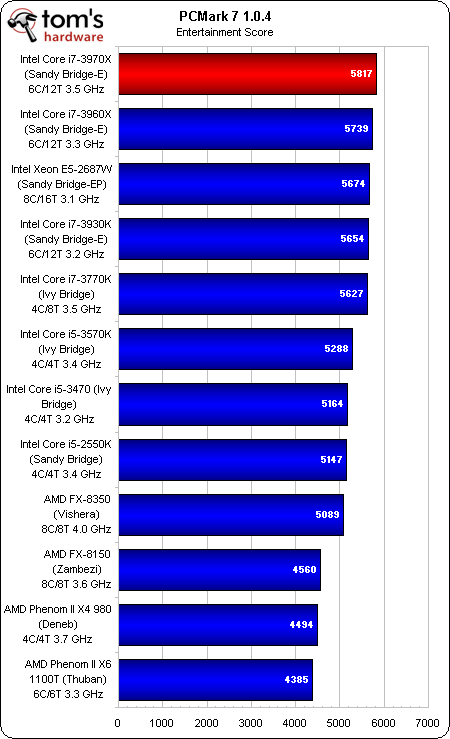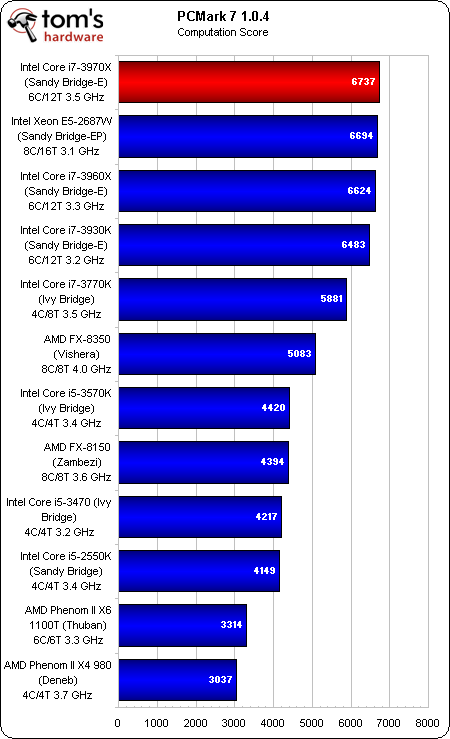Core i7-3970X Extreme Review: Can It Stomp An Eight-Core Xeon?
After one year of dominating the enthusiast space, Intel's Core i7-3960X is being replaced. The new Core i7-3970X features higher clock rates, but also imposes a 150 W TDP. Just for kicks, we're putting it up against another 150 W CPU: the Xeon E5-2687W.
Benchmark Results: PCMark 7
Thanks to its higher clock rate, the Core i7-3970X stands up to Intel’s Core i7-3770K in PCMark’s overall suite score. From experience, we know that several components of this synthetic test are really only able to tax four cores effectively. So, the Sandy Bridge-E-based chip’s extra resources are underutilized, while the more mainstream CPU’s Ivy Bridge architecture gives it an advantage.
The big, expensive Xeon can’t reach quite as high, its Turbo Boost implementation limited to 3.8 GHz. This eight-core processor goes largely unused, forcing it into fourth place.
The same combination of variables is exacerbated in PCMark’s Productivity suite. Three Ivy Bridge-based chips huddle at the top, followed by five variations of Sandy Bridge-based hardware. Four AMD processors bring up the rear, unable to achieve the performance per clock cycle needed to compete.
Parallelism is rewarded in PCMark’s Creativity sub-routine, and Intel’s Core i7-3970X grabs a first-place finish. Why doesn’t the eight-core Xeon get that honor? Presumably, a higher clock rate under full load gives the six-core CPU an advantage over the eight-core model running slower.
The same goes for the Entertainment test, where both the Core i7-3970X and -3960X outmaneuver Intel’s Xeon E5-2687W.
Get Tom's Hardware's best news and in-depth reviews, straight to your inbox.
Current page: Benchmark Results: PCMark 7
Prev Page Test Setup And Software Next Page Benchmark Results: 3DMark 11-
amuffin 100mhz faster than the 3960X, not worth the extra premium.Reply
Same thing goes for the 3960X compared to the 3930K....not worth the extra 100mhz for $400.... -
tumetsu I've recently started facepalming every time I see BF3 in CPU benchmarks. "Boy oh boy, this hasn't been confirmed like a hundred times already but the single player is decidedly graphics-bound, so here, have these charts with identical results anyway."Reply -
dragonsqrrl jaquithBoo on Intel for not enabling all 8-cores especially at that price!They don't have much of a choice when it comes to the i7's. With the 32nm Sandy Bridge-E Intel has to make a choice between prioritizing clocks or core count within a 150W TDP, based on the target workload for a particular processor. For Xeon's the choice is easy, more cores. For desktop applications the choice isn't as clear, but I think most users would still benefit more from a higher clocked 6-core than a lower claocked 8-core. That's slowly changing though.Reply
Intel also doesn't want a situation where their LGA 1155 processors outperform their $1000 extreme edition in lightly threaded workloads, which is yet another reason to favor 6-core for now.
I'd personally like to see an 8-core i7, even if it means lower clocks, but I don't think that'll happen until Ivy Bridge-E. At 22nm Intel probably won't have to make a choice, we'll get the best of both worlds. -
nebun jaquithBoo on Intel for not enabling all 8-cores especially at that price!why would they....they don't need to do it at this time....amd's top cpu is still very slow when compared with even intels mid rannge cpusReply -
unknown9122 Why do people still benchmark on itunes 10.4? 10.7 is out... as for the 8 cores as said above^, there is no need to have more than 6. Because if it had 8, then xeons would not sell to pros.Reply -
BoredErica Why are we not manually overclocking this expensive CPU? Why do we do benchmarks against stock ig 2500k?Reply -
A Bad Day You also forgot something when comparing against Xeon:Reply
Stability test.
Run the i7 for one month under Prime95. It will crash. Run the Xeon for one month under Prime95. If it crashes, then you got a defective Xeon because they're not suppose to crash under 24/7 workload. -
anthonyorr nebunwhy would they....they don't need to do it at this time....amd's top cpu is still very slow when compared with even intels mid rannge cpusReply
Why would you even include the 8350? It is 1/6th the price of this CPU. I couldn't imagine what a modern AMD desktop CPU would consist of at the $1000+ price range.
